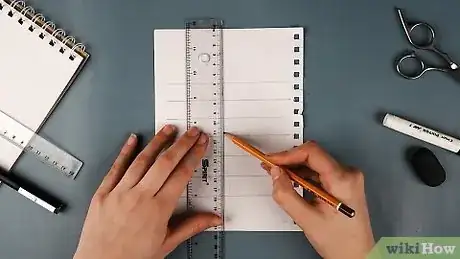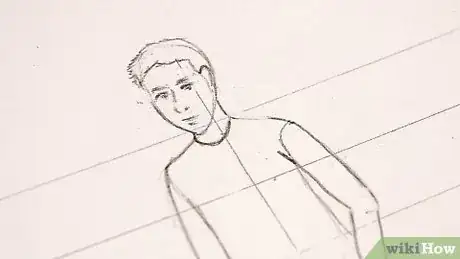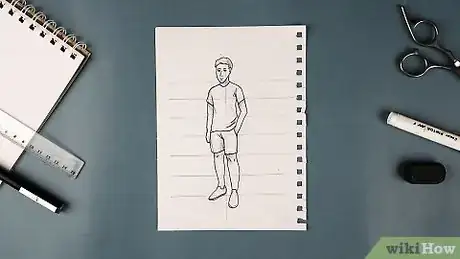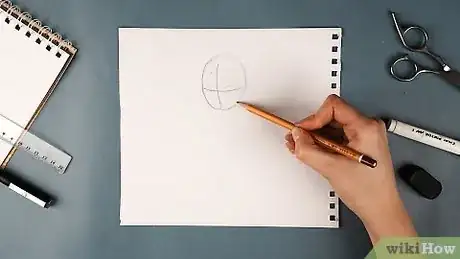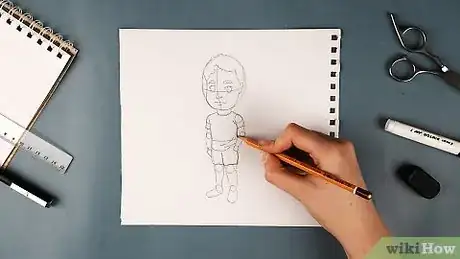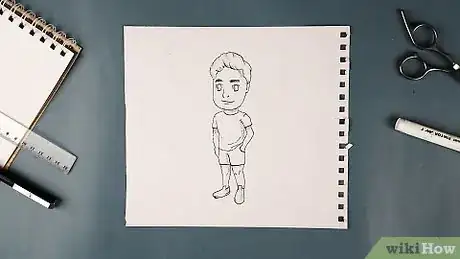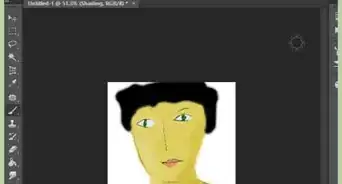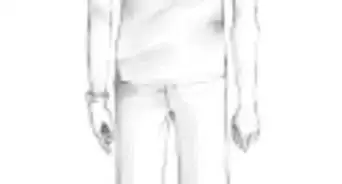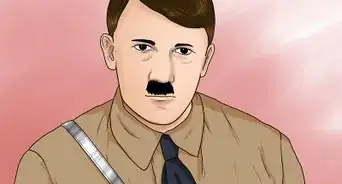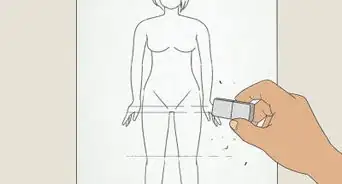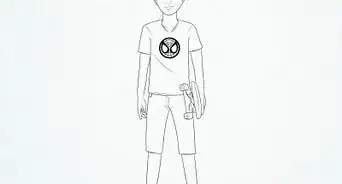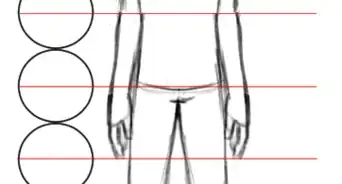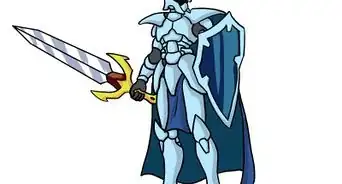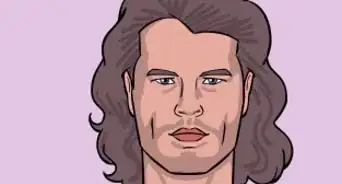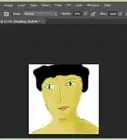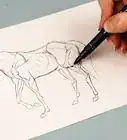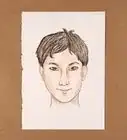This article was co-authored by Claire Wentzel and by wikiHow staff writer, Ali Garbacz. Claire Wentzel is an award-winning Artist and Strategic Creative Consultant. Her business, Red Rose Studios, is based in Las Vegas, Nevada, where she also serves on the Clark County Public Art Committee. With over 20 years of experience, she specializes in mixed media participatory art, brand messaging, and building organizational culture. She earned her BA in Fine Art with Distinction from the University of Colorado-Boulder and completed a painting residency at the International School of Painting, Drawing, and Sculpture. Her chalk mural work has been featured in EdHat and I Madonnari Italian Street Painting Festival advertising.
This article has been viewed 892,012 times.
The art of drawing people is just one of many skills an artist may possess. While every artist may have a different style of drawing, they each had to master some basic principles in order to get started. Whether you want to draw a realistic person or a cartoon, there are some simple tricks you can use to sketch the basic outline of a person. We’re here with a step-by-step guide to help you through the very fundamentals of drawing a person. After reading this, you’ll be on your way to creating a true masterpiece.
Things You Should Know
- When drawing a realistic person, start by dividing your paper into 2 equal columns of 8 rows each and dedicate one space to every body part.
- If drawing a cartoon character, use basic shapes like circles, squares, and rectangles to sketch each body part to the desired proportions.
- After connecting the parts of your basic outline, go in and add more detailed features, such as a face, hair, clothes, and accessories.
- Erase any guide lines and finish by shading in your person to make it more realistic and give it some dimension.
Steps
Drawing a Realistic Person
-
1Draw a vertical line and divide it into 8 equal sections. Each section will be equal to 1 head length, which is the length of your person’s head from top to bottom. Generally, adult figures are 8 head lengths tall, so marking this on your paper at the beginning will help you keep the proportions of your drawing right.[1]
- Draw horizontal lines to divide up the vertical line, and keep in mind that the top horizontal line will be the top of your person’s head and the bottom line will be the bottom of your person’s feet.
- If you want to draw a child, divide the vertical line into fewer head lengths since children are generally shorter than adults. For example, use 3 head lengths for a toddler, or use 6 for a 10-year old.
-
2Sketch rough outlines of the different parts of the body. Lightly sketch the first outlines of your person’s body using the guide lines to help with proportions. Include rough outlines for the head, arms, body, and legs. Don’t worry about making the shapes precise yet since this is just a rough sketch.[2]
- The outline of the head should fall within the top head length section.
- The outlines of the person’s body and arms should start in the second head length section and extend down to the fourth section.
- The outlines of the legs should take up the lower 4 head length sections.
Advertisement -
3Connect and refine the outlines of the different parts of the body. Trace around the outer edges of the body to connect the different outlines so they flow together seamlessly. At this point in the process, start adjusting the proportions of the body to make it look more masculine or feminine, depending on what you’re going for.[3]
- If you want to draw a person with masculine features, broaden the shoulders, chest, and waist, and also take in the hips so they’re narrower. In general, use more angular lines as you define the outline of your drawing.
- To draw a person with feminine features, narrow the shoulders and chest area, and broaden the hips and thighs. Use rounder, softer lines to outline your figure.
-
4Add in smaller details, like the hands and facial features. Sketch the outlines of the feet, hair, and knees. If you’re drawing a person with feminine features, add breasts and round out the hips and thighs. For a person with masculine features, define the muscles on the stomach, chest, and arms.[4]
- At this point, the person's body should be finished.
-
5Draw clothes over the person’s body. Get creative with this part. Draw different styles and cuts of shirts, pants, shoes, and accessories. For a more feminine look, draw a dress or a skirt over your figure. To draw clothes, simply sketch them where they would naturally fall on the person’s body if they were wearing them. Then, erase any parts of the body inside the outlines of the clothes since those areas would be covered up.[5]
-
6Erase any unnecessary lines and shade in your drawing. Go in and erase the vertical and horizontal lines you drew at the beginning to mark the head length sections. You should also erase any outline sketches from earlier that don’t belong in the final drawing. When you’re finished, shade the clothes, skin, and hair to make the person look more realistic and three-dimensional.[6]
- When you’re shading your drawing, pretend there’s an imaginary light source shining on one side of your person. Then, make the parts of the person’s body on the opposite side darker by shading them in more since that’s where the shadows would be.
Drawing a Cartoon Person
-
1Draw an oval and divide it into 4 equal sections. This will be the head of your cartoon person. Make the head bigger than you would for a realistic-looking person since cartoons usually have exaggerated proportions. Use a horizontal and vertical line to divide the oval into 4 equal parts.[7]
- The horizontal and vertical lines in the oval will help you draw the face on your cartoon person later on.
-
2Draw a cylinder for the neck and a rectangle for the torso. Draw the neck so it’s coming out of the bottom center of the oval. Then, draw a rectangle coming off the bottom of the neck to make your cartoon person’s torso.[8]
- If you want to draw a cartoon person with feminine features, make the top of the rectangle narrower and the bottom of the rectangle wider.
- To draw a cartoon person with masculine features, broaden the top of the rectangle and make the bottom narrower.
-
3Draw cylinders for the arms and legs and circles for the knees and elbows. Draw 2 cylinders for each arm and leg with 1 circle in between each pair. The circles will be the outlines of the joints in your drawing. Position the arms and legs depending on what your cartoon person is doing. In general, the arms should extend out of the upper corners of the torso, and the legs should extend down off of the bottom.[9]
- Use straight, angular lines if you’re drawing a masculine cartoon person and round, soft lines if you’re drawing a feminine cartoon person.
-
4Outline the hands and feet. Draw an outline of a hand at the end of each arm. Then, draw the outline of a foot at the end of each leg. Don’t worry about making them precise. You can go back in later and fine-tune them.[10]
-
5Draw the face and hair. For the face, draw the eyes on the horizontal line and the mouth and nose on the vertical line. Since you’re drawing a cartoon and not a realistic person, exaggerate the eyes by making them bigger than the rest of the facial features. When you draw the hair, have the hairline start slightly lower than the top of the head.[11]
- Get creative with the hairstyle you choose. Give your person a simple short hair hairstyle, or try drawing long or curly hair.
-
6Draw clothes on the cartoon person’s body. Just like with the hair, it’s up to you what kind of clothes you want to draw. Try drawing a short or long sleeve shirt, shorts or pants, a dress, a skirt, or any other outfit you’d like. Don’t forget to draw shoes and include any accessories you want your cartoon person to be wearing.[12]
- After you draw the clothes, erase anything that’s inside the outlines of the clothing pieces since those parts of your cartoon person’s body would be covered up.
-
7Smooth out the lines in your drawing and erase any unnecessary lines. Trace around the outside of your drawing to connect all of the outlines you drew earlier. Then, go in and erase any lines that fall within that outline, including the horizontal and vertical lines on the face.[13]
- After you erase all of the background lines in your drawing, you’re finished!
-
8Finished.
Expert Q&A
-
QuestionHow can you get better at drawing faces?
 Claire WentzelClaire Wentzel is an award-winning Artist and Strategic Creative Consultant. Her business, Red Rose Studios, is based in Las Vegas, Nevada, where she also serves on the Clark County Public Art Committee. With over 20 years of experience, she specializes in mixed media participatory art, brand messaging, and building organizational culture. She earned her BA in Fine Art with Distinction from the University of Colorado-Boulder and completed a painting residency at the International School of Painting, Drawing, and Sculpture. Her chalk mural work has been featured in EdHat and I Madonnari Italian Street Painting Festival advertising.
Claire WentzelClaire Wentzel is an award-winning Artist and Strategic Creative Consultant. Her business, Red Rose Studios, is based in Las Vegas, Nevada, where she also serves on the Clark County Public Art Committee. With over 20 years of experience, she specializes in mixed media participatory art, brand messaging, and building organizational culture. She earned her BA in Fine Art with Distinction from the University of Colorado-Boulder and completed a painting residency at the International School of Painting, Drawing, and Sculpture. Her chalk mural work has been featured in EdHat and I Madonnari Italian Street Painting Festival advertising.
Award-Winning Artist and Strategic Creative Consultant Look at them. My favorite technique that I learned for drawing anything, but especially as a good technique to draw portraits, is blind contour drawing. This is an exercise where you look at your subject and you cannot look at your paper or lift up your pencil while you draw. You are training your eye to talk to your hand. This is a fundamental skill that really helps with drawing portraiture in particular.
Look at them. My favorite technique that I learned for drawing anything, but especially as a good technique to draw portraits, is blind contour drawing. This is an exercise where you look at your subject and you cannot look at your paper or lift up your pencil while you draw. You are training your eye to talk to your hand. This is a fundamental skill that really helps with drawing portraiture in particular. -
QuestionHow can you get better at drawing humans in different poses?
 Claire WentzelClaire Wentzel is an award-winning Artist and Strategic Creative Consultant. Her business, Red Rose Studios, is based in Las Vegas, Nevada, where she also serves on the Clark County Public Art Committee. With over 20 years of experience, she specializes in mixed media participatory art, brand messaging, and building organizational culture. She earned her BA in Fine Art with Distinction from the University of Colorado-Boulder and completed a painting residency at the International School of Painting, Drawing, and Sculpture. Her chalk mural work has been featured in EdHat and I Madonnari Italian Street Painting Festival advertising.
Claire WentzelClaire Wentzel is an award-winning Artist and Strategic Creative Consultant. Her business, Red Rose Studios, is based in Las Vegas, Nevada, where she also serves on the Clark County Public Art Committee. With over 20 years of experience, she specializes in mixed media participatory art, brand messaging, and building organizational culture. She earned her BA in Fine Art with Distinction from the University of Colorado-Boulder and completed a painting residency at the International School of Painting, Drawing, and Sculpture. Her chalk mural work has been featured in EdHat and I Madonnari Italian Street Painting Festival advertising.
Award-Winning Artist and Strategic Creative Consultant The human figure is quite challenging to draw. One method is to do warm-up poses, where each pose lasts 30 seconds or maybe a minute. This forces you to get down the essential information as quickly as possible and you won't have time to get bogged down in the details. I think it's just a matter of doing it repetitively and giving yourself the freedom to have it look like whatever it's going to look like. Whatever you see first, just follow that line and then be done and move to the next pose.
The human figure is quite challenging to draw. One method is to do warm-up poses, where each pose lasts 30 seconds or maybe a minute. This forces you to get down the essential information as quickly as possible and you won't have time to get bogged down in the details. I think it's just a matter of doing it repetitively and giving yourself the freedom to have it look like whatever it's going to look like. Whatever you see first, just follow that line and then be done and move to the next pose. -
QuestionWhy do I have to keep erasing lines?
 Community AnswerErasing is a necessary part of art. But be careful and try not to erase too much, otherwise your drawing will look sloppy.
Community AnswerErasing is a necessary part of art. But be careful and try not to erase too much, otherwise your drawing will look sloppy.
References
- ↑ https://crafts.lovetoknow.com/projects/how-draw-person
- ↑ https://crafts.lovetoknow.com/projects/how-draw-person
- ↑ https://crafts.lovetoknow.com/projects/how-draw-person
- ↑ https://crafts.lovetoknow.com/projects/how-draw-person
- ↑ https://crafts.lovetoknow.com/projects/how-draw-person
- ↑ https://crafts.lovetoknow.com/projects/how-draw-person
- ↑ http://www.drawingforall.net/how-to-draw-a-man-for-kids/
- ↑ http://www.drawingforall.net/how-to-draw-a-man-for-kids/
- ↑ http://www.drawingforall.net/how-to-draw-a-man-for-kids/
About This Article
To draw a realistic person, lightly sketch a vertical line down the center of the paper and add 8 horizontal lines to create 8 equally sized sections, which will help you get the proportions right. Next, roughly sketch outlines of the head, arms, body, and legs. Then, connect and refine the lines, adjusting the proportions as needed. Finally, add details like hands, facial features, hair, and feet. Be sure to erase any unnecessary lines and add shading to create dimension. For tips on drawing a cartoon person, read on!
